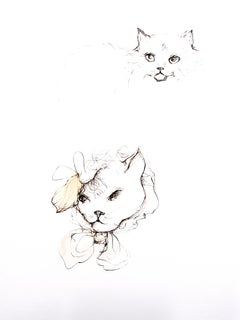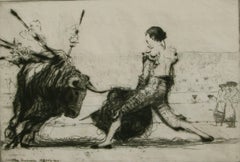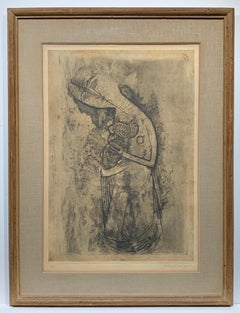Johnny Friedlaender Animal Prints
Polish, 1912-1992
Johnny Gotthard Friedlaender was born in Pless (Silesia) and his early studies were in Breslau under Otto Mueller. In 1936 Friedlaender journeyed to Czechoslovakia, Switzerland, Austria, France and Belgium. At the Hague he held a successful exhibition of etchings and watercolours. He fled to Paris in 1937 as a political refugee of the Nazi regime with his young wife, who was an actress. In that year he held an exhibition of his etchings which included the works: L 'Equipe and Matieres et Formes. From 1939 to 1943 he was interned in a series of concentration camps, but survived.
After freedom in 1944 Friedlaender began a series of twelve etchings entitled Images du Malheur with Sagile as his publisher. In the same year he received a commission to illustrate four books by Freres Tharaud of the French Academy. In 1945 he performed work for several newspapers including Cavalcade and Carrefour. In 1947, he produced the work Reves Cosmiques, and in that same year he became a member of the Salon de Mai, which position he held until 1969. In the year 1948 he began a friendship with the painter Nicolas de Stael and held his first exhibition in Copenhagen at Galerie Birch. The following year he showed for the first time in Galerie La Hune in Paris. After living in Paris for 13 years, Friedlaender became a French citizen in 1950.
Friedlaender expanded his geographic scope in 1951, and exhibited in Tokyo in a modern art show. In the same year he was a participant in the XI Trienale in Milan, Italy. By 1953 he had produced works for a one-man show at the Museum of Neuchâtel and exhibited at the Galerie Moers in Amsterdam, the II Camino Gallery in Rome, in São Paulo, Brazil and in Paris. He was a participant of the French Italian Art Conference in Turin, Italy that same year.
Friedlaender accepted an international art award in 1957, becoming the recipient of the Biennial Kakamura Prize in Tokyo. In 1959 he received a teaching post awarded by UNESCO at the Museum of Modern Art in Rio de Janeiro. By 1968, Friedlaender was travelling to Puerto Rico, New York and Washington, D.C. to hold exhibitions. That year he also purchased a home in the Burgundy region of France. 1971 was another year of diverse international travel including shows in Bern, Milan, Paris, Krefeld and again New York. In the latter city he exhibited paintings at the Far Gallery, a venue becoming well known for its patronage of important twentieth century artists.
1978 brought a retrospective of Friedlaender's works at the Musee d'Art Moderne de la Ville de Paris. He was awarded the Lovis Corinth Prize in Regensburg three years later. On his 75th birthday, Friedlaender was given a retrospective in the Bremen Art Museum. On his 80th birthday he held a retrospective exhibition in Bonn at the municipal council offices. Friedlaender died in Paris at the age of 89.to
2
Overall Width
to
Overall Height
to
2
51
194
162
118
99
2
2
2
1
1
1
2
2
Artist: Johnny Friedlaender
Cats - Original Handsigned Etching, 1963
By Johnny Friedlaender
Located in Paris, IDF
Johnny FRIEDLAENDER (1912 - 1992)
Cats
Original handsigned etching
On vellum BFK Rives
50 x 33 cm (c. 19.6 x 13 inch)
Excellent condition, the sheet is slightly yellowed
Category
1960s Modern Johnny Friedlaender Animal Prints
Materials
Etching
Fishes - Original Handsigned Etching, 1963
By Johnny Friedlaender
Located in Paris, IDF
Johnny FRIEDLAENDER (1912 - 1992)
Fishes
Original handsigned etching
On vellum BFK Rives
50 x 33 cm (c. 19.6 x 13 inch)
Excellent condition, the sheet is slightly yellowed
Category
1960s Modern Johnny Friedlaender Animal Prints
Materials
Etching
Related Items
Leonor Fini - Cats - Original Etching
By Leonor Fini
Located in Collonge Bellerive, Geneve, CH
Leonor Fini - Cats - Original Engraving
Mme.Helvetius' Cats
Original etching created in 1985, Printed Signature (LF).
Conditions: excellent
Edition: 100
Support: Arches paper.
Dimensions: Paper dimensions: 44 x 28 cm
Editions: Moret, Paris.
Leonor Fini is considered one of the most important women artists of the mid-twentieth century, along with Leonora Carrington, Frida Kahlo, Meret Oppenheim, Remedios Varo, and Dorothea Tanning – most of whom Fini knew well. Her career, which spanned some six decades, included painting, graphic design, book illustration, product design (the renowned torso-shaped perfume bottle for Schiaparelli’s Shocking), and set and costume design for theatre, ballet, opera, and film. In this compellingly readable, exhaustively researched account, author Peter Webb brings Fini’s provocative art and unconventional personal life, as well as the vibrant avant-garde world in which she revolved, vividly in life.
Born in Buenos Aires in 1907 (August 30 – January 18, 1996, Paris) to Italian and Argentine parents, Leonor grew up in Trieste, Italy, raised by her strong-willed, independent mother, Malvina. She was a virtually self-taught artist, learing anatomy directly from studying cadavers in the local morgue and absorbing composition and technique from the Old Masters through books and visits to museums.
Fini’s fledging attempts at painting in Trieste let her to Milan, where she participated in her first group exhibition in 1929, and then to Paris in 1931.
Her vivacious personality and flamboyant attire instantly garnered her a spotlight in the Parisian art world and she soon developed close relationships with the leading surrealist writers and painters, including Paul Eluard, Salvador Dali, Man Ray, and Max Ernst, who became her lover for a time. The only surrealist she could not abide because of his misogyny was André Breton. Although she repeatedly exhibited with them, she never considered herself a surrealist. The American dealer Julien Levy,
very much impressed by Fini’s painting and smitten by her eccentric charms, invited her to New York in 1936, where she took part in a joint gallery exhibition with Max Ernst and met many American surrealists, including Joseph Cornell and Pavel Tchelitchew. Her work was included in MoMA’s pivotal Fantastic Art, Dada and Surrealism exhibition, along with De Chirico, Dali, Ernst, and Yves Tanguy.
In 1939 in Paris she curated an exhibition of surrealist furniture for her childhood friend Leo Castelli for the opening of his first gallery.
Introductions to her exhibition catalogues were written by De Chirico, Ernst, and Jean Cocteau.
A predominant theme of Fini’s art is the complex relationship between the sexes, primarily the interplay between the dominant female and the passive, androgynous male. In many of her most powerful works, the female takes the form of a sphinx, often with the face of the artist. Fini was also an accomplished portraitist; among her subjects were Stanislao Lepri...
Category
1980s Modern Johnny Friedlaender Animal Prints
Materials
Etching
A Fierce Bull
By James McBey
Located in Storrs, CT
A Fierce Bull. 1911. Drypoint. Hardie 108. 5 3/8 x 8 (sheet 8 5/16 x 11 7/8). Edition 8. An exceptional impression with rich drypoint burr printed on antique laid paper. A proof of t...
Category
1910s Modern Johnny Friedlaender Animal Prints
Materials
Drypoint, Etching
From the suite "Les Fables De La Fontaine" original etching
By Marc Chagall
Located in San Francisco, CA
Artist: Marc Chagall (Russian, 1887-1985)
Title: From the suite "Les Fables De La Fontaine"
Year: 1927
Medium: Original etching
Edition: fom...
Category
Early 20th Century Modern Johnny Friedlaender Animal Prints
Materials
Etching
$2,100
H 25.5 in W 22.25 in D 1.75 in
Salvador Dalí, "Le Chateau de Gala", original etching, hand colored, signed
By Salvador Dalí
Located in Chatsworth, CA
Salvador Dalí
Le Chateau de Gala (Gala's Castle) from After 50 Years of Surrealism
Original etching, hand colored
1974
Image size: 15 3/...
Category
1970s Modern Johnny Friedlaender Animal Prints
Materials
Etching
$4,400 Sale Price
44% Off
H 26 in W 19.75 in
The Lion and the Gnat
By Marc Chagall
Located in San Francisco, CA
Artist: Marc Chagall (Russian, 1887-1985)
Title: The Lion and the Gnat
Year: 1927
Medium: Original etching
Edition: fom the unumbered edition of 200
Paper: Japan
Image (plate mark) ...
Category
Early 20th Century Modern Johnny Friedlaender Animal Prints
Materials
Etching
Animal Kingdom (Magnificent Jungle Cats)
By Louise Nevelson
Located in Fairlawn, OH
Animal Kingdom (Magnificent Jungle Cats)
Etching, 1953-1955
Signed and titled in pencil by the artist (see photos)
Annotated: "First Proof" (see photo)
Estate stamp verso (see photo)...
Category
1950s American Modern Johnny Friedlaender Animal Prints
Materials
Etching
The Two Bulls And The Frog, From the suite Les Fables De La Fontaine
By Marc Chagall
Located in San Francisco, CA
Artist: Marc Chagall (Russian, 1887-1985)
Title: The Two Bulls And The Frog
Year: 1927
Medium: Original etching
Edition: fom the unumbered edition of 200
Pa...
Category
Early 20th Century Modern Johnny Friedlaender Animal Prints
Materials
Etching
$1,488
H 26.75 in W 22.25 in D 1.5 in
Insects - Etching by Sergio Barletta - 1974
By Sergio Barletta
Located in Roma, IT
Insects is an etching realized by Sergio Barletta in 1974.
Hand-signed in pencil on the lower right. Numbered on the lower left in Roman numerals, from the edition of XXX prints.
...
Category
1970s Modern Johnny Friedlaender Animal Prints
Materials
Etching
$211 Sale Price
40% Off
H 6.7 in W 9.85 in D 0.04 in
Leonor Fini - Magical Cat - Original Etching
By Leonor Fini
Located in Collonge Bellerive, Geneve, CH
Leonor Fini - Cats - Original Engraving
Mme.Helvetius' Cats
Original etching created in 1985, Printed Signature (LF).
Conditions: excellent
Edition: 100
Support: Arches paper.
Dimensions: Paper dimensions: 44 x 28 cm
Editions: Moret, Paris.
Leonor Fini is considered one of the most important women artists of the mid-twentieth century, along with Leonora Carrington, Frida Kahlo, Meret Oppenheim, Remedios Varo, and Dorothea Tanning – most of whom Fini knew well. Her career, which spanned some six decades, included painting, graphic design, book illustration, product design (the renowned torso-shaped perfume bottle for Schiaparelli’s Shocking), and set and costume design for theatre, ballet, opera, and film. In this compellingly readable, exhaustively researched account, author Peter Webb brings Fini’s provocative art and unconventional personal life, as well as the vibrant avant-garde world in which she revolved, vividly in life.
Born in Buenos Aires in 1907 (August 30 – January 18, 1996, Paris) to Italian and Argentine parents, Leonor grew up in Trieste, Italy, raised by her strong-willed, independent mother, Malvina. She was a virtually self-taught artist, learing anatomy directly from studying cadavers in the local morgue and absorbing composition and technique from the Old Masters through books and visits to museums.
Fini’s fledging attempts at painting in Trieste let her to Milan, where she participated in her first group exhibition in 1929, and then to Paris in 1931.
Her vivacious personality and flamboyant attire instantly garnered her a spotlight in the Parisian art world and she soon developed close relationships with the leading surrealist writers and painters, including Paul Eluard, Salvador Dali, Man Ray, and Max Ernst, who became her lover for a time. The only surrealist she could not abide because of his misogyny was André Breton. Although she repeatedly exhibited with them, she never considered herself a surrealist. The American dealer Julien Levy,
very much impressed by Fini’s painting and smitten by her eccentric charms, invited her to New York in 1936, where she took part in a joint gallery exhibition with Max Ernst and met many American surrealists, including Joseph Cornell and Pavel Tchelitchew. Her work was included in MoMA’s pivotal Fantastic Art, Dada and Surrealism exhibition, along with De Chirico, Dali, Ernst, and Yves Tanguy.
In 1939 in Paris she curated an exhibition of surrealist furniture for her childhood friend Leo Castelli for the opening of his first gallery.
Introductions to her exhibition catalogues were written by De Chirico, Ernst, and Jean Cocteau.
A predominant theme of Fini’s art is the complex relationship between the sexes, primarily the interplay between the dominant female and the passive, androgynous male. In many of her most powerful works, the female takes the form of a sphinx, often with the face of the artist. Fini was also an accomplished portraitist; among her subjects were Stanislao Lepri...
Category
1980s Modern Johnny Friedlaender Animal Prints
Materials
Etching
l' Ivrogne et sa Femme
By Marc Chagall
Located in San Francisco, CA
Artist: Marc Chagall (Russian, 1887-1985)
Title: l'Ivrogne et sa Femme
Year: 1927
Medium: Original etching
Edition: fom the unumbered edition of 200
Paper: Montval Laid paper
Image ...
Category
Early 20th Century Modern Johnny Friedlaender Animal Prints
Materials
Etching
Leonor Fini - Cats Trio - Original Hand-Signed Etching
By Leonor Fini
Located in Collonge Bellerive, Geneve, CH
Leonor Fini - Cats - Original Engraving
Mme.Helvetius' Cats
Original etching created in 1985
Hand-Signed
Conditions: excellent
Edition: 71/100
Support: Arches paper.
Dimensions: Pape...
Category
1980s Modern Johnny Friedlaender Animal Prints
Materials
Etching
$1,410
H 17.33 in W 11.03 in D 0.04 in
Leonor Fini - Cat - Original Etching
By Leonor Fini
Located in Collonge Bellerive, Geneve, CH
Leonor Fini - Cats - Original Engraving
Mme.Helvetius' Cats
Original etching created in 1985, Printed Signature (LF).
Conditions: excellent
Edition: 100
Support: Arches paper.
Dimensions: Paper dimensions: 44 x 28 cm
Editions: Moret, Paris.
Leonor Fini is considered one of the most important women artists of the mid-twentieth century, along with Leonora Carrington, Frida Kahlo, Meret Oppenheim, Remedios Varo, and Dorothea Tanning – most of whom Fini knew well. Her career, which spanned some six decades, included painting, graphic design, book illustration, product design (the renowned torso-shaped perfume bottle for Schiaparelli’s Shocking), and set and costume design for theatre, ballet, opera, and film. In this compellingly readable, exhaustively researched account, author Peter Webb brings Fini’s provocative art and unconventional personal life, as well as the vibrant avant-garde world in which she revolved, vividly in life.
Born in Buenos Aires in 1907 (August 30 – January 18, 1996, Paris) to Italian and Argentine parents, Leonor grew up in Trieste, Italy, raised by her strong-willed, independent mother, Malvina. She was a virtually self-taught artist, learing anatomy directly from studying cadavers in the local morgue and absorbing composition and technique from the Old Masters through books and visits to museums.
Fini’s fledging attempts at painting in Trieste let her to Milan, where she participated in her first group exhibition in 1929, and then to Paris in 1931.
Her vivacious personality and flamboyant attire instantly garnered her a spotlight in the Parisian art world and she soon developed close relationships with the leading surrealist writers and painters, including Paul Eluard, Salvador Dali, Man Ray, and Max Ernst, who became her lover for a time. The only surrealist she could not abide because of his misogyny was André Breton. Although she repeatedly exhibited with them, she never considered herself a surrealist. The American dealer Julien Levy,
very much impressed by Fini’s painting and smitten by her eccentric charms, invited her to New York in 1936, where she took part in a joint gallery exhibition with Max Ernst and met many American surrealists, including Joseph Cornell and Pavel Tchelitchew. Her work was included in MoMA’s pivotal Fantastic Art, Dada and Surrealism exhibition, along with De Chirico, Dali, Ernst, and Yves Tanguy.
In 1939 in Paris she curated an exhibition of surrealist furniture...
Category
1980s Modern Johnny Friedlaender Animal Prints
Materials
Etching
Previously Available Items
Woman with Cat
By Johnny Friedlaender
Located in Wilton Manors, FL
Johnny Friedlaender (1912-1992). Woman with Cat, ca. 1960. Etching on wove paper. Plate measures 16 x 23 inches; 24 x 32 inches framed. Edition of 50. S...
Category
Mid-20th Century Cubist Johnny Friedlaender Animal Prints
Materials
Etching
Horses - Original Handsigned Etching, 1963
By Johnny Friedlaender
Located in Paris, IDF
Johnny FRIEDLAENDER (1912 - 1992)
Horses
Original handsigned etching
On vellum BFK Rives
50 x 33 cm (c. 19.6 x 13 inch)
Excellent condition, the sheet is slightly yellowed
Category
1960s Modern Johnny Friedlaender Animal Prints
Materials
Etching
Flying Birds - Original Handsigned Etching, 1963
By Johnny Friedlaender
Located in Paris, IDF
Johnny FRIEDLAENDER (1912 - 1992)
Flying Birds
Original handsigned etching
On vellum BFK Rives
50 x 33 cm (c. 19.6 x 13 inch)
Excellent condition, the sheet is slightly yellowed
Category
1960s Modern Johnny Friedlaender Animal Prints
Materials
Etching
Johnny Friedlaender animal prints for sale on 1stDibs.
Find a wide variety of authentic Johnny Friedlaender animal prints available for sale on 1stDibs. You can also browse by medium to find art by Johnny Friedlaender in etching and more. Much of the original work by this artist or collective was created during the 1960s and is mostly associated with the modern style. Not every interior allows for large Johnny Friedlaender animal prints, so small editions measuring 13 inches across are available. Customers who are interested in this artist might also find the work of Mordecai Moreh, Bernard Buffet, and Ray H. French. Johnny Friedlaender animal prints prices can differ depending upon medium, time period and other attributes. On 1stDibs, the price for these items starts at $378 and tops out at $378, while the average work can sell for $378.


